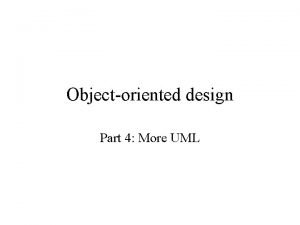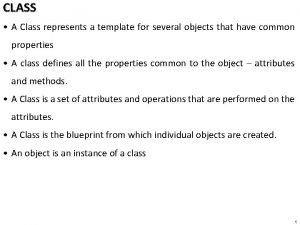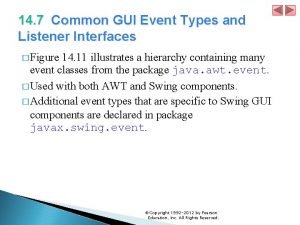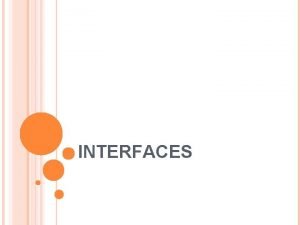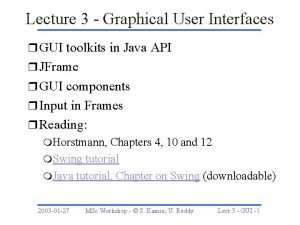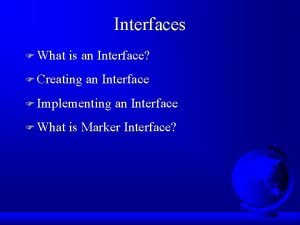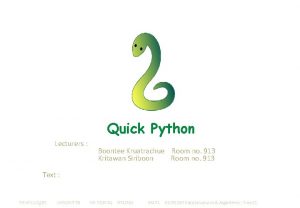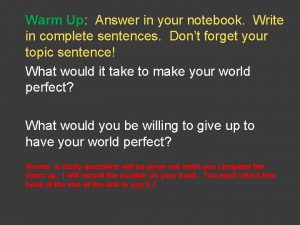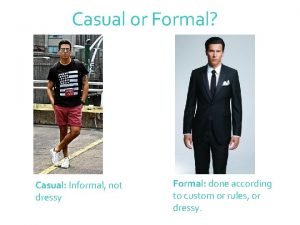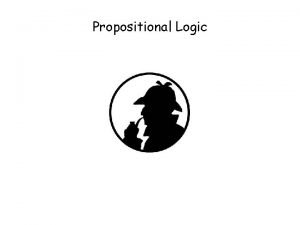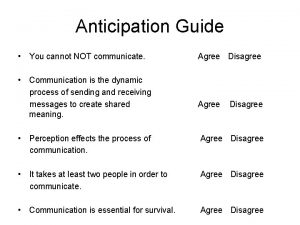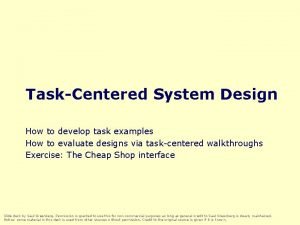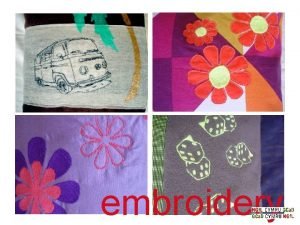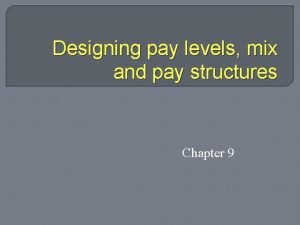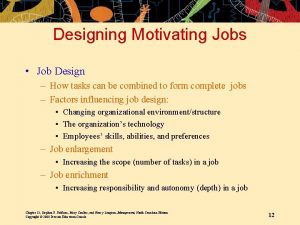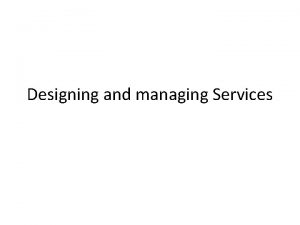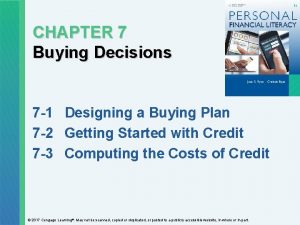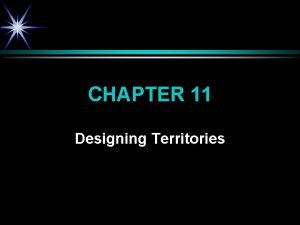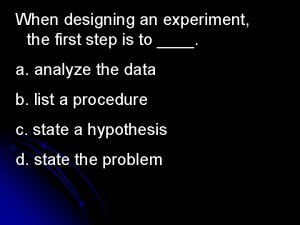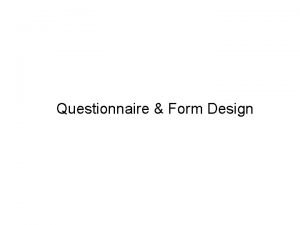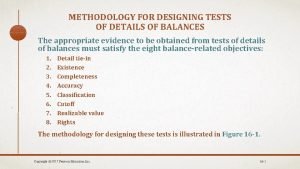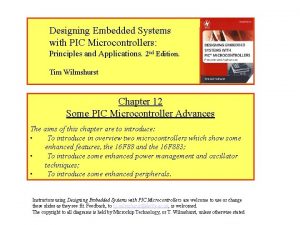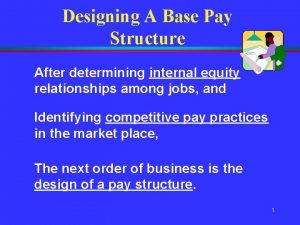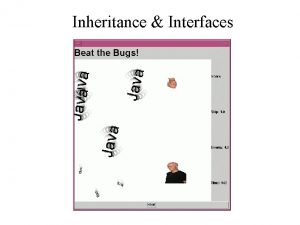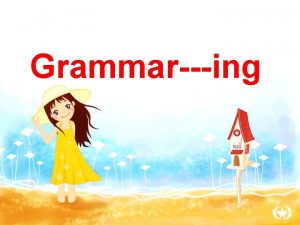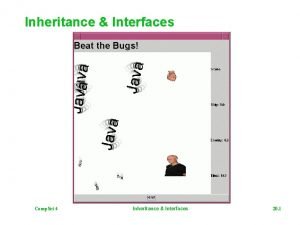Designing Designing Interfaces How Not to Write a






































































































- Slides: 102

Designing “Designing Interfaces: ” How Not to Write a Pattern Catalog Jenifer Tidwell UPA 2007 Wednesday, June 13

Prologue: a little history The year was 1997. Read “Design Patterns” (Gang of Four) and “A Pattern Language” (Alexander).

Developers designing UIs… • They knew the principles of good design. • They understood the importance of usability testing. • But they couldn’t get past rote copying. “Microsoft did it this way, so we should do it this way too. ”

Could patterns help? “These ideas work. Pick what you want from them, and ignore the rest. ” “And by the way, here’s why they work, if you’re curious. ”

• • Hypertext Video games Consumer electronics Spoken interfaces Print design Data visualization Cartography etc… Wanted to apply knowledge from other fields



But was it useful? Sort of.

1999 -2002: no work done • I couldn’t solve certain problems • Come back to it with a fresh mind • Learn more about graphic design, industrial design, etc.

Two jobs later…

…and then…

How Not to Write a Pattern Catalog: 1. Treat it as a fun theoretical exercise. (Design it to be used)

1. Design it to be used

1. Design it to be used • Prefer concrete to abstract


1. Design it to be used • Prefer concrete to abstract • The format doesn’t have to be GOF, or Alexandrian, or …


• • Examples Context Problem Forces Solution Resulting Context Diagram Notes

• • Examples Context Problem Forces Solution Resulting Context Diagram Notes • • • Primary Example What Use When Why How Other Examples

But what about interoperability? …

1. Design it to be used • Prefer concrete to abstract • The format doesn’t have to be GOF, or Alexandrian, or … • The organization just needs to function; it doesn’t have to be perfect

But organization is important! • Help readers find patterns • Makes a statement about how the patterns should be used It’s an information architecture problem.

So how should we categorize them? • By scale?

So how should we categorize them? • By scale? • By user task?

So how should we categorize them? • By scale? • By user task? • By problem statement?

1. What is the basic shape of the content? 2. What is the basic shape of the actions taken with the artifact? 3. How does the content or available actions unfold before the user? 4. How does the artifact generally use space and the user’s attention? 5. How is the content or action organized into working surfaces? 6. How can the user navigate through the artifact? 7. What specific actions should the user take? etc…

So how should we categorize them? • • By scale? By user task? By problem statement? By design stage? …This kind of worked.

1. 2. 3. 4. 5. 6. 7. 8. 9. What Users Do Organizing the Content Getting Around Organizing the Page Commands and Actions Showing Complex Data Getting Input from Users Builders and Editors Making It Look Good

1. Design it to be used • Prefer concrete to abstract • The format doesn’t have to be GOF, or Alexandrian, or … • The organization just needs to function; it doesn’t have to be perfect • Don’t sweat the “language” stuff

“The language is a good one … when it is morphologically and functionally complete. “It is morphologically complete when the patterns together form a complete structure, filled out in all its detail, with no gaps. “And it is functionally complete when … the patterns, as a system, generate only those forces which they themselves resolve. ”

Lowered standard: just make sure patterns link to each other. • • • Is-a Leads-to Alternative-to Works-well-with etc.

How Not to Write a Pattern Catalog: 1. Treat it as a fun theoretical exercise. (Design it to be used) 2. Write it for all designers, everywhere. (Focus on your users)

2. Focus on your users • • Solve the design problems they have Not everyone’s Use vocabulary they know Use familiar examples

2. Focus on your users “Microsoft did it this way, so we should do it this way too. ”

• • Hypertext Video games Consumer electronics Spoken interfaces Print design Data visualization Cartography etc…

• • Hypertext Video games Consumer electronics Spoken interfaces Print design Data visualization Cartography etc… Only Math. Works software.

How Not to Write a Pattern Catalog: 1. Treat it as a fun theoretical exercise. (Design it to be used) 2. Write it for all designers, everywhere. (Focus on your users) 3. Try to capture all design knowledge as patterns. (Other forms can be better)

3. Other forms can be better When you’ve got a hammer…

3. Other forms can be better My definition of “pattern: ” • • • Suggestion, not command Product, not process Captures relationships among elements Usable across platforms Clearly improves the user experience

3. Other forms can be better • • • Principles Heuristics Style guides and standards Components Genres / idioms

3. Other forms can be better Principles: “Make your interfaces easy to learn. ” “Prevent errors. ” Bedrock design concepts Commands, not suggestions Very abstract, high-level

3. Other forms can be better Heuristics: “Performance, cost, schedule: pick two. ” “Expand the scope to simplify the problem. ” Strategies for solving problems Commands, not suggestions Process, not product

3. Other forms can be better Style guides and standards: “If an item is too long to fit in the list box, insert an ellipsis in the middle and preserve the beginning and end of the item. ” Design parameters for a class of products Commands, not suggestions Often very specific

3. Other forms can be better Components: “Here’s the code for a sortable. ” “Here’s a set of icons for use in drag-anddrop. ” Individual elements of a UI Not relationships among them Often very specific

3. Other forms can be better Genres / idioms: Form Information graphic Searchable online repository Categories of UI types; “set the rules” A context, not a pattern!

3. Other forms can be better What about new innovations?

3. Other forms can be better Another problem: patterns are verbose.

http: //www. visual-literacy. org/periodic_table. html

3. Other forms can be better What had I done wrong? … • Tried to “patternize” genres/idioms • Tried to “patternize” information shapes • Attempted to create too many patterns for controls • Almost published “Inverted-L” as a pattern

How Not to Write a Pattern Catalog: 1. Treat it as a fun theoretical exercise. (Design it to be used) 2. Write it for all designers, everywhere. (Focus on your users) 3. Try to capture all design knowledge as patterns. (Other forms can be better) 4. Describe the obvious, without offering any genuine (Think hard about use contexts) insight.

4. Think hard about use contexts Problem: You need X. Solution: Use X. (with apologies to Martijn) You’re stuck in Obviousland!



Diversion: pattern writing How I write a pattern: 1. Notice a recurring design element. 2. Work up and down the abstraction ladder. 3. Understand why it works. 4. Figure out the context -- when it should or shouldn’t be used. This is what gets you out of Obviousland. 5. Name it.

Diversion: pattern writing Pattern discovery in another domain…

Step 1: find a recurring element What’s common here? • Brown the meat in oil, on high heat • Remove it before it’s cooked • The rest of the dish involves liquid • Return the meat to the liquid, eventually

Step 2: walk the abstraction ladder Up, up: • Does it work with vegetables too? • Is the liquid required? • Would dry heat work, instead of frying? But these seem to lose the “sense of the pattern”

Step 3: why does it work? Research uncovers “Maillard reactions”… • Produce hundreds of flavor components • High heat (360+) • Requires both proteins and sugars • Deglazing often done too

Step 4: figure out use context …What, you want me to be a chef too?

Step 4: figure out use context • We discovered that flavor depth is added • We ruled out vegetables and delicate oils • We decided that liquids define the pattern as much as the meat-browning does Counterexamples?

Step 5: name it Any ideas?

How Not to Write a Pattern Catalog: 1. Treat it as a fun theoretical exercise. (Design it to be used) 2. Write it for all designers, everywhere. (Focus on your users) 3. Try to capture all design knowledge as patterns. (Other forms can be better) 4. Describe the obvious, without offering any genuine (Think hard about use contexts) insight. (Visual examples are critical) 5. Don’t bother with screenshots; they’re too hard.

5. Visual examples are critical • They help you define the pattern




5. Visual examples are critical • They help you define the pattern • Put your “evidence” out there



5. Visual examples are critical • They help you define the pattern • Put your “evidence” out there • Explain in pictures, not just words



5. Visual examples are critical • • They help you define the pattern Put your “evidence” out there Explain in pictures, not just words Inspiring in their own right

How Not to Write a Pattern Catalog: 1. Treat it as a fun theoretical exercise. (Design it to be used) 2. Write it for all designers, everywhere. (Focus on your users) 3. Try to capture all design knowledge as patterns. (Other forms can be better) 4. Describe the obvious, without offering any genuine (Think hard about use contexts) insight. (Visual examples are critical) 5. Don’t bother with screenshots; they’re too hard. (Find out how it’s really used)

6. Find out how it’s really used Conducted a survey of DI readers to find out how they use patterns (Not statistically significant)

6. Find out how it’s really used • 130 respondents • 20 were primarily developers • 50 were designers of some sort • A mix of managers, researchers, etc. • Majority have been in that role 2 -8 years • But they do many different things…



6. Find out how it’s really used The book says: • Advice on specific design problems • Learn about UI design • Use examples as “sourcebook” • Terminology for describing design • Creative inspiration

“How often do you or your team refer to the book for advice when you're designing interfaces? ” Total: 80% Most common answer: “Once or twice during a project” (40%)

“Has the book changed your mind about any design decisions? ” “Yes: ” 50% Sample answers: balanced palette, date choosers, data graphics, page organization

“Identify chapters that taught you something you didn’t know before” Total: 55% Most common answer: Chapter 4, “Organizing the Page”

“Identify chapters that taught you something you didn’t know before” What Users Do Organizing the Content Getting Around Organizing the Page Actions and Commands Showing Complex Data Getting Input from Users Builders and Editors Making it Look Good

“Identify chapters that taught you something you didn’t know before” …but many respondents said “all” or “none. ”

“Have you used the book to help or encourage other people to learn about UI design? ” “Yes: ” 70%

“Have you or your team used the book to find or brainstorm new design ideas? ” “Yes: ” 65%

“Have you used the pattern names when talking about design? ” Total: 75% “Have you used the pattern names in design specs or other design documents? ” “Yes: ” 35%

6. Find out how it’s really used • Advice on specific design problems • Learn about UI design • Use examples as “sourcebook” • Terminology for describing design • Creative inspiration …yes, patterns are used in all these ways!

6. Find out how it’s really used Some other tidbits… • 2/3 of workplaces “informally encourage use of UI patterns” • 1/3 formally use patterns “to enforce consistent design”



6. Find out how it’s really used Frequently-named patterns: • • • Few Hues, Many Values Right/Left Alignment Responsive Disclosure Diagonal Balance Deep Background

6. Find out how it’s really used Pattern names used: • Responsive Disclosure (9 mentions) • Input Hints (6) • Wizard, Progress Indicator, Row Striping, Liquid Layout, Closable Panels (4 -5)

6. Find out how it’s really used On changed design decisions… “considering an action panel to replace a convoluted menu system” “Simplifying color and making the page balance diagonally. ” “Color Coding of pages was a new concept”

6. Find out how it’s really used On changed design decisions… “I've moved away from linear wizards and toward 2 -panel selectors, to give users more control over how they work with info or move through a process. ” “It changed my mind about web page organization. I tend to think of them as inherently textual and organize them from left to right. I plan to spend more time considering the graphical nature of the data I'm presenting and thinking about grouping

6. Find out how it’s really used General comments… • Good summation or reference for familiar ideas • Useful as a “memory jogger” • Different platforms: good • More patterns! • More AJAX!

6. Find out how it’s really used General comments… “Synthesis, reinforcement, clarification: this is what the book was mostly useful for. ” “…it has boosted my design decisions and given me confidence to go ahead with the designs. ” “…many times I think of one way of doing things and after consulting with the book I have new ideas. ”

6. Find out how it’s really used Conclusions: • Patterns are used in the ways we predicted

6. Find out how it’s really used Conclusions: • Patterns are used in the ways we predicted • They help both novice and skilled designers

6. Find out how it’s really used Conclusions: • Patterns are used in the ways we predicted • They help both novice and skilled designers • Many workplaces are aware of them and use them

6. Find out how it’s really used Conclusions: • Patterns are used in the ways we predicted • They help both novice and skilled designers • Many workplaces are aware of them and use them • Repository of design wisdom, more than a teaching tool (but both)

How Not to Write a Pattern Catalog: 1. Treat it as a fun theoretical exercise. (Design it to be used) 2. Write it for all designers, everywhere. (Focus on your users) 3. Try to capture all design knowledge as patterns. (Other forms can be better) 4. Describe the obvious, without offering any genuine (Think hard about use contexts) insight. (Visual examples are critical) 5. Don’t bother with screenshots; they’re too hard. (Find out how it’s really used)
 Which is not an objective of designing interfaces?
Which is not an objective of designing interfaces? Interface and dialogue design
Interface and dialogue design Toggle reveal tools
Toggle reveal tools Vocab level d unit 3
Vocab level d unit 3 Expressive interface
Expressive interface![[web user interface] [web user interface]](data:image/svg+xml,%3Csvg%20xmlns=%22http://www.w3.org/2000/svg%22%20viewBox=%220%200%20200%20200%22%3E%3C/svg%3E) [web user interface]
[web user interface] Uml interfaces are used to:
Uml interfaces are used to: Office interface vs industrial interface
Office interface vs industrial interface Difference between abstract classes and interfaces
Difference between abstract classes and interfaces Interface and abstract class difference in java
Interface and abstract class difference in java What are expressive interfaces?
What are expressive interfaces? Blueprint interfaces
Blueprint interfaces Gui event types in java
Gui event types in java Property management system interfaces
Property management system interfaces Examples of colloids
Examples of colloids Java static import
Java static import Joe hogan openet
Joe hogan openet Basal hlr
Basal hlr Expressive interfaces
Expressive interfaces Ieee srs
Ieee srs Team interfaces
Team interfaces Micros e interfaces
Micros e interfaces Why are user interfaces hard to implement
Why are user interfaces hard to implement Gulf of execution and evaluation
Gulf of execution and evaluation Mdi vs sdi
Mdi vs sdi Java gui for r
Java gui for r Interfaces inteligentes
Interfaces inteligentes Abstract classes in java
Abstract classes in java User interfaces design dc
User interfaces design dc Interface f
Interface f Gsm
Gsm Communication interfaces in embedded systems
Communication interfaces in embedded systems Teknik mapping pada memori
Teknik mapping pada memori Peanamen reddit
Peanamen reddit Jeus8 기동
Jeus8 기동 In your notebook write question about the next school year
In your notebook write question about the next school year If you're not confused you're not paying attention
If you're not confused you're not paying attention Casual informal
Casual informal Attention is not not explanation
Attention is not not explanation Too broad too narrow
Too broad too narrow If not p then q
If not p then q Just about right scale
Just about right scale Love is not all rhyme scheme
Love is not all rhyme scheme Ears that hear and eyes that see
Ears that hear and eyes that see Sit pp
Sit pp If you can't measure it quote
If you can't measure it quote We will not be moved you're standing with us
We will not be moved you're standing with us Not a rustling leaf, not a bird in flight
Not a rustling leaf, not a bird in flight You cannot not communicate
You cannot not communicate Task design sample
Task design sample Message strategy example
Message strategy example Designing a secure local area network
Designing a secure local area network Patrick is designing a large
Patrick is designing a large Rpa concept in rpd
Rpa concept in rpd Designing customer oriented marketing channels
Designing customer oriented marketing channels Consequences of an internally aligned structure
Consequences of an internally aligned structure The process of designing and maintaining an environment
The process of designing and maintaining an environment Designing of hris
Designing of hris Thematic unit examples
Thematic unit examples You are designing a sticker to advertise your band
You are designing a sticker to advertise your band Computer aided embroidery and designing
Computer aided embroidery and designing Designing marketing channels
Designing marketing channels Ros smith
Ros smith Pay level and pay mix
Pay level and pay mix Designing motivating jobs adalah
Designing motivating jobs adalah Marketing programs to build brand equity
Marketing programs to build brand equity Output design
Output design Designing effective hrd programs
Designing effective hrd programs Designing classroom language tests
Designing classroom language tests Designing and managing services in marketing
Designing and managing services in marketing Managing products and brands
Managing products and brands Developing oral and online presentations
Developing oral and online presentations Zip line slope and sag
Zip line slope and sag Truss connection details
Truss connection details Key elements of customer driven marketing strategy
Key elements of customer driven marketing strategy Quality service by design
Quality service by design An organized method for making good buying decisions
An organized method for making good buying decisions Chapter 4 product and service design
Chapter 4 product and service design Fleishman job analysis system
Fleishman job analysis system Designing a global sneaker
Designing a global sneaker Designing and managing services
Designing and managing services Chapter 14 designing and managing services ppt
Chapter 14 designing and managing services ppt Designing effective input
Designing effective input Designing territory
Designing territory Designing and implementing brand marketing programs
Designing and implementing brand marketing programs Designing and implementing branding strategies
Designing and implementing branding strategies Web designing dmis
Web designing dmis Architecture is the art and science of designing buildings
Architecture is the art and science of designing buildings Evaluating the variables affecting channel structure
Evaluating the variables affecting channel structure Designing and managing integrated marketing communications
Designing and managing integrated marketing communications First step in designing an experiment
First step in designing an experiment The hand warmer design challenge
The hand warmer design challenge Designing a questionnaire
Designing a questionnaire Product oriented assessment example
Product oriented assessment example Designing adaptive organizations
Designing adaptive organizations Designing tests
Designing tests Designing product families
Designing product families Designing learner-centric moocs
Designing learner-centric moocs Textbook design and development procedure
Textbook design and development procedure Designing embedded systems with pic microcontrollers
Designing embedded systems with pic microcontrollers Tableau designing efficient workbooks
Tableau designing efficient workbooks Designing pay structure
Designing pay structure Multiple look and feel standards
Multiple look and feel standards
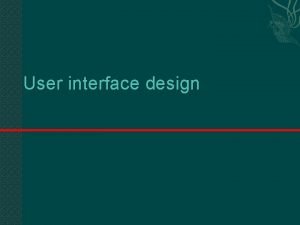




![[web user interface] [web user interface]](https://slidetodoc.com/wp-content/uploads/2020/12/3515569_e80293ca9d02734a3126f3e8d1d1c3b7-300x225.jpg)
